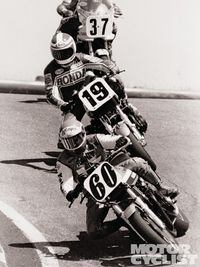Many years ago at Daytona, I was talking to Wayne Rainey after an AMA Superbike practice session. Another rider had gone down in front of him, a fairly uneventful low-side, which he commented on: "I have no idea how that guy managed to crash going so slow."
This brings up an interesting question: How can a slower rider on comparable equipment crash when a faster rider does not?
You could say that the best riders make the best decisions: when to brake, how hard to brake, when and how hard to roll on the throttle, where to turn, etc. Let’s look at the same thing from another angle: A good rider also knows when _not _to do something.
Here’s an example: A rider enters a corner, and things seem okay as he tips in. As he approaches the middle of the turn, he becomes concerned about his entrance speed and, although he’s not running wide, he gets the idea that he _might _run wide. He then launches a preemptive strike on the problem that doesn’t exist. He turns it in harder, and ends up running toward the _inside _of the turn. Now he’s in damage-control mode. He stands the bike up to avoid the dirt, and where does that put him? Wide—just where he didn’t want to be. Had he stuck with his original plan and not second-guessed himself, he would have been fine.
This is common if a rider has some earlier crash on his mind. He wants to ride but doesn’t want to crash, so he spends his time _not crashing _rather than riding. This is particularly troubling to a rider who crashed but has no idea why. In contrast to this, I’ve seen racers have a huge crash, then get on a spare bike and win the very next race. You could say that racer had nerves of steel, or no mortgage or kids to worry about. However, selling your house and abandoning your kids probably won’t make you fearless.
What's the solution? Many say time in the saddle. It's not so much time in the saddle as what you are doing during that time. I had a rider come to me after a day of training and tell me, "I came here with 17 years of riding experience. I found out I only had one year of experience 17 times."
If we look at preemptive strikes as riding problems, we find that what we are really dealing with are riders’ uncertainties. Resolving those uncertainties has been a major part of my job for the last 34 years. A rider goes into a turn, becomes uncertain, and _then _starts giving the bike all manner of control inputs that he thinks will make him certain and comfortable? I think not. That’s like stabbing at random buttons on a large machine to try and control it.
If we break down terms like certainty _and _confidence, we find the common denominator of a predictable result. Gaining certainty or confidence is something we do have a solution for, and here's how it breaks down: 1) Practice one individual skill at a time; 2) While doing so, ride at about 75 percent of your limit; and 3) From there, incrementally increase your pace.
When I started the California Superbike School in 1980, students were briefed in the morning followed by track time. As the curriculum evolved, we found that riders made much greater progress when given one particular thing to focus on at a comfortable pace. After confidence was gained on that skill, another was addressed, and so on. We broke it down to more riding sessions with specific goals. This approach actually transferred from my training racers one-on-one. I found that even AMA Pros could only effectively resolve problems with their riding when they compartmentalized those problems. If it worked for them, it should work for everyone.
What’s the message? Whenever and wherever you ride, pick one aspect of your riding, back down the pace, and explore that particular technique. From there, you’ll build confidence—and reduce your number of preemptive strikes.











/cloudfront-us-east-1.images.arcpublishing.com/octane/VZZXJQ6U3FESFPZCBVXKFSUG4A.jpg)
/cloudfront-us-east-1.images.arcpublishing.com/octane/QCZEPHQAMRHZPLHTDJBIJVWL3M.jpg)
/cloudfront-us-east-1.images.arcpublishing.com/octane/HXOUJXQWA5HBHGRO3EMJIGFMVI.jpg)

/cloudfront-us-east-1.images.arcpublishing.com/octane/3TIWWRV4JBBOLDVGRYECVVTA7Y.jpg)
/cloudfront-us-east-1.images.arcpublishing.com/octane/KIX5O23D5NAIBGFXBN3327DKZU.jpg)
/cloudfront-us-east-1.images.arcpublishing.com/octane/7GJYDUIPXRGMTMQKN6ONYOLBOU.jpg)
/cloudfront-us-east-1.images.arcpublishing.com/octane/MUQLOVLL2ZDGFH25ILABNBXKTI.jpg)
/cloudfront-us-east-1.images.arcpublishing.com/octane/TNOU5DNE2BC57MFPMGN2EIDXAM.jpg)
/cloudfront-us-east-1.images.arcpublishing.com/octane/GTCXACQGJ5HAPDTGWUQKDEH44E.jpg)
/cloudfront-us-east-1.images.arcpublishing.com/octane/S35YGSEMEZB4BLTDJTSZPF4GLA.jpg)
/cloudfront-us-east-1.images.arcpublishing.com/octane/5UOT6HPX2JFMRJAX6EH45AR4MQ.jpg)
/cloudfront-us-east-1.images.arcpublishing.com/octane/OKWOJWAKP5EP3OACCRRWPCIX2Q.jpg)
/cloudfront-us-east-1.images.arcpublishing.com/octane/2WF3SCE3NFBQXLDNJM7KMXA45E.jpg)
/cloudfront-us-east-1.images.arcpublishing.com/octane/G4MG6OUCJNBSHIS2MVVOTPX65E.jpg)
/cloudfront-us-east-1.images.arcpublishing.com/octane/IIGGWFOTOJGB7DB6DGBXCCMTDY.jpg)
/cloudfront-us-east-1.images.arcpublishing.com/octane/QSTCM6AVEZA5JJBUXNIQ3DSOF4.jpg)
/cloudfront-us-east-1.images.arcpublishing.com/octane/U4I7G625B5DMLF2DVIJDFZVV6M.jpg)
/cloudfront-us-east-1.images.arcpublishing.com/octane/B6XD6LS6IVCQPIU6HXDJSM3FHY.jpg)
/cloudfront-us-east-1.images.arcpublishing.com/octane/ICL63FEDDRDTTMINYICCEYGMDA.jpg)
/cloudfront-us-east-1.images.arcpublishing.com/octane/FCGZHQXRBZFLBAPC5SDIQLVF4I.jpg)
/cloudfront-us-east-1.images.arcpublishing.com/octane/WNOB6LDOIFFHJKPSVIWDYUGOPM.jpg)

/cloudfront-us-east-1.images.arcpublishing.com/octane/X33NU3E525ECRHXLNUJN2FTRKI.jpg)